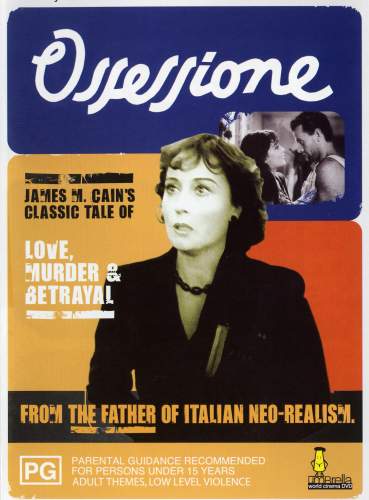Ossessione (1943) |
|
Ossessione (1943) |
|


|
| BUY IT |
| General | Extras | ||
| Category | Drama |
Main Menu Audio Biographies-Crew-Luchino Visconti (Director) Trailer-La Terra Trema, Jean De Florette, Cinema Paradiso Trailer-Manon Des Sources |
|
| Rating |

|
||
| Year Of Production | 1943 | ||
| Running Time | 134:16 | ||
| RSDL / Flipper | RSDL (84:02) | Cast & Crew | |
| Start Up | Menu | ||
| Region Coding | 1,2,3,4,5,6 | Directed By | Luchino Visconti |
|
Studio
Distributor |
ICI Umbrella Entertainment |
Starring |
Clara Calamai Massimo Girotti Dhia Cristiani Elio Marcuzzo Vittorio Duse Michele Riccardini Juan de Landa |
| Case | Amaray-Transparent-Secure Clip | ||
| RPI | $29.95 | Music | Giuseppe Rosati |
| Video | Audio | ||
| Pan & Scan/Full Frame | Full Frame | Italian Dolby Digital 2.0 (448Kb/s) | |
| Widescreen Aspect Ratio | 1.29:1 | ||
| 16x9 Enhancement | No | ||
| Video Format | 576i (PAL) | ||
| Original Aspect Ratio | 1.37:1 | Miscellaneous | |
| Jacket Pictures | Yes | ||
| Subtitles | English | Smoking | Yes |
| Annoying Product Placement | No | ||
| Action In or After Credits | No | ||
Gino (Massimo Girotti) is a drifter who wanders into the roadside restaurant of the middle-aged and portly Bragana (Juan de Landa). There he meets Bragana's wife Giovanna (Clara Calamai), who is young and attractive. Bragana hires Gino to do some odd jobs around the restaurant, but when Bragana heads into town to get an automotive part, Gino and Giovanna consummate their mutual attraction.
Soon tiring of carrying on behind Bragana's back, Gino leaves for the city with a man he meets on the train, Lo Spagnolo. A chance meeting some weeks later with Bragana leads Gino back to the restaurant, into a web of murder.
This was the second film adaptation of James M. Cain's novel The Postman Always Rings Twice, though there is no credit in the film. I've read that the distribution of the film was stopped due to legal action, though it's hard to believe that in 1943, when Italy was at war with America that the legal niceties in relation to copyright would have been followed. I've also read that the film was successfully defended against a charge of plagiarism. It is obvious though that the film is based on the novel.
This was the first film directed by Luchino Visconti, an Italian aristocrat who financed most of his films himself using the family fortune. Freed from the strictures of the Italian studio system and rigid government censorship, Visconti made a film that contains considerable eroticism, and includes pregnancy outside marriage, prostitution and overtones of homosexuality. It has been said that the Fascist government seized the original negative and that the film survived only because Visconti managed to smuggle a print out of the country. All existing prints of the film derive from that copy, which explains the state of the film on this disc (and DVDs in other regions as well).
My review of the 1946 MGM version stated that that was probably the best of the four adaptations of the novel. It had been some time since I had seen Ossessione, and having now seen both within a short period of time I will have to revise my opinion. Ossessione is a superior film, which instead of neatly bringing all of the elements of the noir thriller together comes across as more of a character study. The murder does not occur until the second half of the film, and the investigation of and resolution of the crime take a back seat to the exploration of the doomed relationship between Gino and Giovanna, and the effect of the crime on each of them. The film unfolds at its own pace, typical of Visconti whose leisurely films were rarely under two hours in length. Yet it is never boring and does not seem padded. A remarkable achievement for the first film of any director, this realistic and de-glamourised movie is well worth seeking out.
The film is presented in an aspect ratio of 1.29:1 and is not 16x9 enhanced. The original aspect ratio was 1.37:1.
As stated above, all available material of the film apparently comes from a single print. So while this is not the ideal transfer that could be imagined, it is probably as good as we are going to get short of a full restoration. It looks like little or no attempt has been made to clean up the film artefacts.
For the most part the transfer is sharp. There are a few sequences where part of the frame is slightly out of focus. This may have been deliberate, as it appears to be in the source material rather than because of a poor transfer. Otherwise this is a good and detailed transfer. Contrast seems satisfactory, if slightly bright at times.
The black and white film comes up well in this edition, though some low level noise is visible. Otherwise there is a reasonable range of greys on display, with some deep blacks.
I did not notice any film to video artefacts worth noting. Film artefacts though are present in great numbers throughout, though the frequency of them reduces in the last half-hour of the film. You can see everything from dirt and specks to larger print damage, splice marks and reel change markings. For the first hour or so there is a white tramline scratch at the right of frame, and later in the film there are much more severe scratches that are of shorter duration.
There is some flickering in the brightness, the frame jumps occasionally and there is a little wobble at times. The video is also quite grainy throughout much of the running time.
Subtitles are provided and are burned-in. They are in a white type-face with a transparent grey bar behind each line. Not all of the dialogue is subtitled, but the unsubtitled dialogue does not seem to be critical to understanding the film. The subtitles are well timed and I did not see any grammatical or spelling errors.
The disc is RSDL-formatted with the layer change placed at 84:02. The break occurs during a scene and is a little disruptive. With a bit of thought it could have been better placed.
| Sharpness | |
| Shadow Detail | |
| Colour | |
| Grain/Pixelization | |
| Film-To-Video Artefacts | |
| Film Artefacts | |
| Overall |
The sole audio track is Italian Dolby Digital 2.0 mono.
Like the video, the audio has significant problems. There is omnipresent crackle and occasional pops. At times there is a metallic buzz in the background. Otherwise the audio is not bad, if very constricted. Dialogue is clear and would probably be intelligible if I could speak the language. It seems a lot of post-dubbing was done, as lip-sync is variable.
The music score is by Giuseppi Rosati, and despite being overly dramatic and portentous at times, it works well with the film. In fact it improves as the film goes on.
| Dialogue | |
| Audio Sync | |
| Clicks/Pops/Dropouts | |
| Surround Channel Use | |
| Subwoofer | |
| Overall |
The static main menu has some of the music score as background.
A four-page biography of the director.
Trailers for other Umbrella releases.
NOTE: To view non-R4 releases, your equipment needs to be multi-zone compatible and usually also NTSC compatible.
The US Region 1 comes from Image Entertainment. It sounds as though it has a worse transfer than the Region 4, but without having seen it it is hard to tell. It comes without any extras but it does have removable subtitles.
The UK Region 2 is from the BFI. From the description, it sounds as though we get the same transfer in Region 4 including the burned-in subtitles, but without an audio commentary by two academics. The back of the Region 4 cover does not credit the BFI, but a company called Beta who perhaps supplied the materials to both the BFI and Umbrella.
The BFI is probably the primary choice given the inclusion of the audio commentary, though it is reported to be dry and has lengthy dead spots. If you just want the film, then the Region 4 is worth the outlay.
A superb film which seems much better on a second viewing.
The audio and video transfers are very good, but the original material, sadly, is in less than pristine condition.
No substantial extras.
| Video | |
| Audio | |
| Extras | |
| Plot | |
| Overall |
| Review Equipment | |
| DVD | Pioneer DV-S733A, using Component output |
| Display | Sony 86CM Trinitron Wega KVHR36M31. Calibrated with Ultimate DVD Platinum. This display device is 16x9 capable. |
| Audio Decoder | Built in to DVD player, Dolby Digital, dts and DVD-Audio. Calibrated with Ultimate DVD Platinum. |
| Amplification | Sony TA-DA9000ES |
| Speakers | Main: Tannoy Revolution R3; Centre: Tannoy Sensys DCC; Rear: Richter Harlequin; Subwoofer: JBL SUB175 |